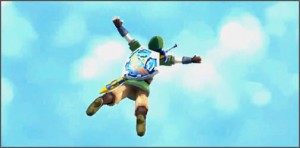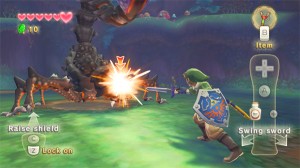The Legend of Zelda: Skyward Sword is a delight. It is the game that Zelda fans hoped Twilight Princess would be and an impressive combination of innovative steps forward for the series and a return to what made some of the classics so great. While it suffers from the weakest companion Link has had in a long time and some strange repetition, the faults are overshadowed by the fantastic pacing, characters, story-telling, and fun that Skyward Sword provides.
Skyward Sword, unsurprisingly, is a coming of age story. However, this time Link and Zelda are already very familiar with each other as the game begins. They are both students on an island in the sky known as Skyloft. The plot is quickly set in motion as a storm throws Zelda out of the clouds and down to the unknown surface below. It is an extremely strong beginning that swiftly makes it clear that Skyward Sword houses the best Zelda character yet.
Only Tetra from Wind Waker has really allowed Zelda to be a character and not just a princess, and Skyward Sword takes it to another level by letting Zelda have complex motivations and an important side of the story reserved for her. The game also allows Link and Zelda to have their closest relationship yet and Nintendo finally returns the story-telling’s focus to character. This focus combined with spot-on motion capture and great facial animations make for powerful and subtle character-driven scenes on a level that has not been seen in a Zelda game since the N64 days.
The video game industry is filled with capable studios that churn out high-production epic cut-scenes regularly. Developers like Naughty Dog and Bioware have writers that are arguably the very strongest in the industry, but Nintendo flexed a long-dormant muscle with Skyward Sword that proves that the best writing chops are not necessarily required to create some of the most engaging and emotionally poignant moments in gaming. Every single scene will not etch itself into gamer’s hearts, but when it counts, Skyward Sword delivers the goods.
This trend continues to make a rich and dense world throughout. Twilight Princess often leaned on a crutch of references and failed to deliver a distinct personality of its own, Skyward Sword creates a Zelda world positively different than any other while simultaneously embracing and celebrating the others as well. There are explicit gameplay and character references to Ocarina of Time, Majora’s Mask, Wind Waker, Twilight Princess, Phantom Hourglass, and even Spirit Tracks, but Skyward Sword always makes sure not to lose its unique mood.
Characters that would be throwaways in a game like Twilight Princess are given depth and sometimes a larger role and funnier lines than one might expect. In fact, the dialogue and story are often surprising. Link is not always the golden child and even allies do not hesitate to call him out if they have an issue with him. In this way, the player actually feels progression as Link must work to earn respect that he will find in the strangest and most satisfying places.
Despite the plethora of fantastic original and returning characters, not every one is a winner. After the strong companion showings of the King of Red Lions in Wind Waker and Midna in Twilight Princess, Fi almost always falls flat with her half-baked robot dialect and general lack of personality. She has moments of greatness and she provides very helpful information including individual performance reports for every enemy, but is ultimately a showing of rare blandness in the game.
The primary villain, Ghirahim is also spotty. While a far stronger character than Fi, he is not always believable in his clichéd rants about his evil desires. His theatrics are amusing, and he is part of a few powerful scenes, but his convenient “I’ll deal with you later” exits are cause for a few eye rolls.
The structure of Skyward Sword‘s gameplay and progression is an odd beast. In one sense, the Zelda formula is entirely intact for better or worse. Link travels to the forest, mountain, and desert locales encountering dungeons as well as new and old races along the way. He gains new items to help him access areas that were previously impossible to reach. However, now the areas connecting the dungeons are filled with puzzles and enemies in a way that has not been the case since the 2D Zelda games. Also, Link is constantly re-visiting old areas, but in ways that are surprisingly fresh. Skyward Sword not only has fine story pacing, but excellent gameplay pacing. The player never feels underpowered or overwhelmed, but is constantly given new ways to play up until the final moments of the title. New mini-games are unlocked, old areas are presented in entirely new ways, and expected patterns are often tossed on their head.
While the player will be largely impressed and enthralled with how old areas can be brought to life in unexpected ways, there are a few duds. In the main quest, three different bosses are played multiple times with few – and in one case no – changes from the previous battle. Also, there are a couple cases in which a retread does feel like unnecessary filler, but these cases are certainly exceptions.
Two major gameplay changes that signify a step forward for the series are Link’s stamina bar and the ability to upgrade potions, items, and equipment. The former finally puts an end to the need to incessantly roll around to get to areas quicker. Link has a finite stamina bar that will cause him to be temporarily exhausted if over-extended. This exhaustion will leave him vulnerable and cause him to lose any grip he has on a cliff or vine-covered wall. The bar replenishes quickly and is used if Link sprints, climbs, or performs spinning attacks. The strategy added from this simple Shadow of the Colossus-esque feature is invaluable and it is difficult to remember Zelda games without it now.
With the upgrade system, money and collectables finally make a difference in a Zelda game. Link’s wallet can become very large quite quickly, and it will be needed. Shops have useful items, and upgrades go a long way, so even sums of over 1000 rupees can easily be drained from one visit to the bazaar. Bugs and enemy drops also become very important resources. No longer does anything found in battle feel useless. Every item can be used to make Link feel more powerful in a very tangible way. Also, these resources can be sold back – albeit inconveniently – if a player feels he has too many of a certain type.
Another feature unique to the game is the implementation of ground-up motion controls. It would be dangerous to go into Skyward Sword with the thought that “motion controls” are equal to “beginner controls”. While this is largely the case in the extremely waggle-heavy Wii lineup, Skyward Sword is very different. No player will be an instant expert. Flying around Skyloft will initially be clumsy, sword-fighting will initially be amateur, and to blame undeveloped skills on poor controls would be entirely inaccurate. Practice and skill pays off in Skyward Sword and underestimating the game to be aimed at beginners would be a mistake that would cause a player frustration throughout the experience.
Hardcore gamers will likely even be at a disadvantage with the controls. Those familiar with the timing and button-mashing needed in every other Zelda title – including Twilight Princess – might become frustrated when trying to translate those traditional methods to Skyward Sword. Zelda veterans are likely to have a difficult time unlearning their habits in order to be truly successful while playing.
In fact, the only real issue with the controls is that they are – in fact – motion controls. Any player stubbornly opposed to playing any title without a traditional controller will be unlikely to be converted. However, those players who pictured a Zelda game first when the Wii was announced will finally be appeased. Albeit over half a decade late, this is the game that gamers thought the Wii would provide. The controls work, they are well implemented, and they benefit from practice and skill.
Strange to think that this much can be said about this game without a single mention of its visuals. Only Mario Galaxy 2 shares Skyward Sword‘s ability to make a player forget he is playing a game on the vastly under-powered Wii system. Combining the visual styles of Wind Waker and Twilight Princess was the perfect move and Skyward Swords‘s water colour graphics are truly glorious to behold. Up until the final moments, players will find themselves admiring their surroundings. This is the best Zelda has ever looked.
All this text still barely satisfies the content and personality overflowing from The Legend of Zelda: Skyward Sword. Even without mentioning the charming 50s gangster-style Mogmas, the challenging “Hero Mode”, or the brilliant orchestrated musical score, there is more praise to be said about the game. Players who have zero patience with the Zelda formula or motion controls will find no solace in this title. However, for the rest of the gaming population, Nintendo has given endless care and attention to its one true Wii Zelda title and it is easily the greatest game on the system. It may not be the best in the series, but it is the best in a long time, a worthy origin story, and a must-play for even vague fans of the series.
Full disclosure: the author was provided with a free copy of the game for review purposes.


